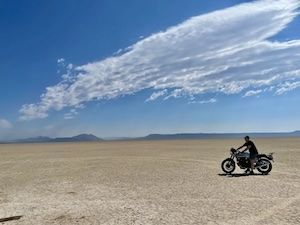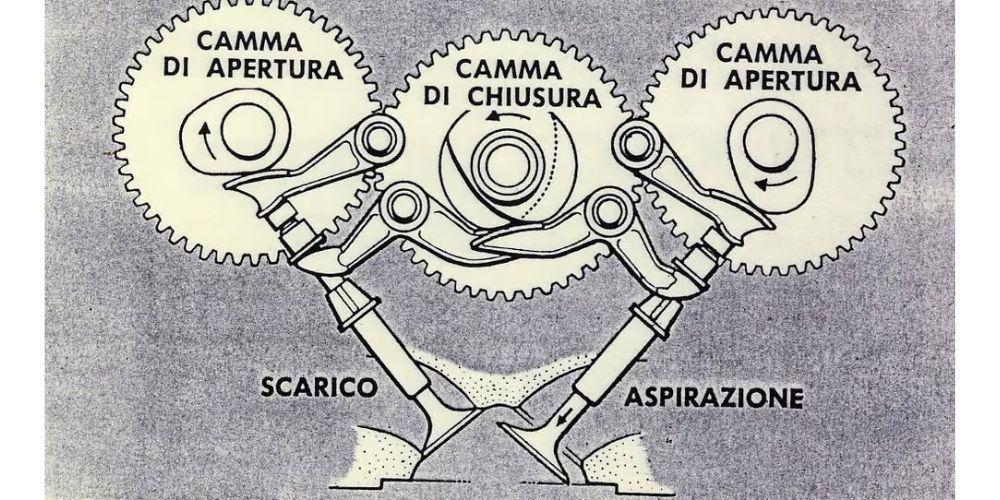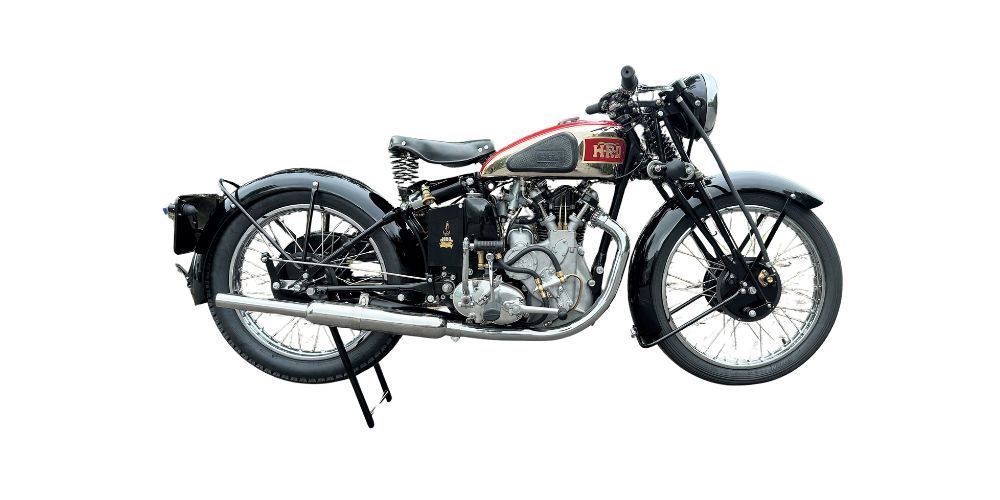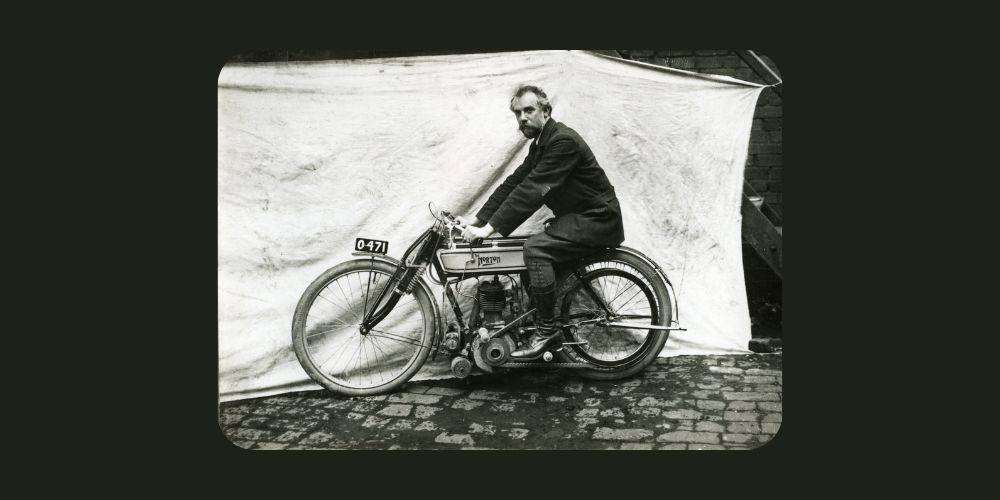Vintage Italian Classic: 1982 Laverda 500 Montjuic
The 1982 Laverda 500 Montjuic, is more than just an old motorbike; it's an icon of racing history and Italian design. Born from Laverda's racing victories, it held everyone's gaze with its daring looks and speed, gracefully combining style with performance. This motorcycle doesn't just talk the talk - it revs the rev of a robust 497cc engine that can command up to 50bhp at soaring heights of 9000rpm. And if you think this is all about raw power, think again. Its artful design stands as a testament to an era where machines were not only built to be fast but also beautiful. Let's begin by looking closer at this model...
The 1982 Laverda 500 Montjuic had a claimed top speed of 125mph, making it an exciting and potent choice for riders seeking thrills on the open road.

Overview of the Montjuic Model
The 1982 Laverda 500 Montjuic was more than just a motorcycle; it was a statement of fierce style and exceptional performance. Its roots traced back to the racing triumphs of Laverda, a testament to the brand's commitment to pushing the boundaries of speed and innovation on the track.
The Montjuic was designed not just for the casual rider, but for those seeking an adrenaline rush every time they mounted their machine. This wasn't a bike for the faint of heart; it demanded respect and commanded attention with its aggressive styling and unapologetic ferocity on the road.
What set the Montjuic apart was not just its racing pedigree, but also its distinctive design that made it stand out even among its contemporaries. From its sleek fairings to its bold color choices, every aspect of the Montjuic exuded confidence and power, reflecting a blend of heritage and modernity in one compelling package.
When it came to sheer performance, the Montjuic didn't hold back. It delivered an exhilarating ride, embracing every twist and turn with unwavering agility. The roar of its engine became a signature sound on roads and race tracks, a symphony of power that left an indelible mark on anyone fortunate enough to witness it in action.
Enthusiasts weren't just drawn to the Montjuic for its reputation; many were lured by the rich history behind its name. Named after Barcelona's street circuit, where Laverda twins had excelled in racing, it carried with it an unparalleled legacy that added to its allure.
Unfolding before us is an enthralling narrative of speed, style, and undeniable character—the 1982 Laverda 500 Montjuic holds a special place in motorcycle history.
Performance and Engine Details
The Laverda 500 Montjuic was truly a force to be reckoned with, boasting a robust 497cc, DOHC air-cooled engine. This powerplant delivered an impressive 50bhp at 9000rpm, making it a remarkable feat of engineering, especially for its time. As riders ignited the engine, they were met with an exhilarating burst of energy that perfectly embodied the soul of this legendary Italian motorcycle.
The peak power delivery at high RPMs added to the Montjuic's reputation for spirited performance, granting riders an experience best described as scintillating. Whether it was slicing through curving roads or tearing down long stretches of highway, the Montjuic offered a blend of raw power and finesse that truly set it apart. It wasn't just about getting from point A to point B; it was about experiencing every twist and turn of the journey in pure Italian style.
Consider this: riding the Montjuic was akin to harnessing a whirlwind of power and grace under your control. The rush of wind, the roar of the engine, and the assured handling came together to create an experience that remained unmatched for decades.
From its impeccable power delivery to its astonishing top speed, every aspect of the Montjuic's performance exemplified Laverda's commitment to crafting motorcycles with prowess and passion.
Now, let's unravel more about this iconic motorcycle and what made it so unique on the road.
Aesthetic Design and Styling
The 1982 Laverda 500 Montjuic was more than a motorcycle; it embodied Italian engineering and craftsmanship. Its distinct roadster design with eye-catching features set it apart from its contemporaries. The adjustable 'Jota bars' allowed riders to customize their riding position for optimal comfort and control, while the small handlebar fairing added a touch of sleekness to the overall profile.
When it comes to aesthetics, the devil is in the details. Laverda's traditional racing orange paint not only added a pop of color but also paid homage to its racing heritage. Coupled with the seat hump and side panels crafted by Midlands specialist Screen and Plastic, the Montjuic exuded an aura of uniqueness and exclusivity. These elements combined to create an unmistakable visual identity that reflected both power and elegance—a striking paradox that captivated motorcycle enthusiasts across the globe.
Imagine riding through the streets or cruising down winding roads with the vibrant orange bodywork reflecting off the sun, all while embracing the symphony of its powerful engine. The visual appeal of the Montjuic wasn't just skin deep; it was a statement, a testament to Italian artisanship and innovation.
But it wasn't just about looks; the aesthetic design of the Montjuic also spoke volumes about its performance. The carefully sculpted contours and aerodynamic features weren't merely decorative—they were purposeful, enhancing both its appearance and function. This blend of style and substance encapsulated the essence of the Laverda 500 Montjuic, making it a timeless symbol of excellence in motorcycle design.
Unraveling the complexities of its aesthetic allure allows us to appreciate how every element of the Montjuic's design contributed to its iconic status, transcending mere functionality to achieve true artistry on two wheels.
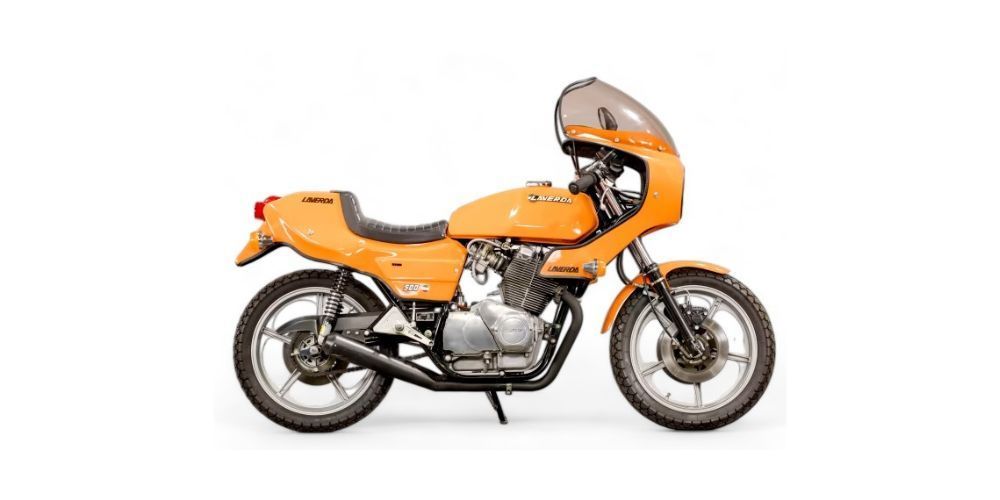
Historical Impact of Laverda Brand
Laverda has left an indelible mark on the motorcycle industry, with a lasting legacy that resonates through the design and performance of its iconic models. The historical significance of the Laverda brand can be traced back to its roots in racing success and a steadfast commitment to precision engineering.
From the outset, Laverda distinguished itself through its relentless pursuit of innovation and excellence in both design and functionality. The brand's racing heritage served as a fertile ground for pushing the boundaries of performance, setting new benchmarks that established Laverda as a formidable force in the competitive world of motorcycles.
The introduction of the Montjuic model further solidified Laverda's position as an industry trailblazer. Designed for aggressive and fast riding, the Montjuic epitomized Laverda's commitment to creating motorcycles that not only performed exceptionally but also exuded character and personality.
It's crucial to understand that the influence of the Montjuic model extended beyond its individual characteristics. Its existence served as a testament to Laverda's overarching impact on the development of classic motorcycles.
The 1982 Laverda 500 Montjuic, often revered as a timeless classic, not only embodied innovation and refined engineering but also contributed extensively to shaping the landscape of vintage Italian motorcycles. Its unique blend of style, sound, and personality cemented its position as an enduring symbol of Laverda's prowess in crafting exceptional machines.
Furthermore, by seamlessly blending elements of heritage and modernity, Laverda successfully etched its name into the annals of motorcycle history. The Montjuic model stands as a poignant example of how the brand's relentless pursuit of excellence manifested in tangible form—a machine that encapsulated the very essence of timeless appeal.
In essence, Laverda's influence within the motorcycle industry is profoundly intertwined with the remarkable legacy of the Montjuic model, symbolizing a dedication to innovation, performance, and an unwavering commitment to creating motorcycles that transcend time.
This rich tapestry of history and tradition set the stage for exceptional features that defined the racing prowess of the Montjuic model, shedding light on its enduring influence on competitive motorcycle culture.
Race Features of Montjuic
The Montjuic's lineage is deeply entwined with racing, echoing its Italian heritage and resonating with classic motorcycle enthusiasts. Its name itself is a nod to Barcelona's famous street circuit, where Laverda twins achieved remarkable victories—a connection that underscores the deeply ingrained racing DNA within the Montjuic.
To further emphasize its racing capabilities, Laverda promoted a one-make race series called the Coppa Laverda, showcasing a Formula version of the Montjuic. The Formula bikes were purpose-built for high-performance racing, featuring low handlebars that allowed riders to crouch into an aerodynamic position, hotted-up engines that delivered exhilarating speed, stripped-down chassis for reduced weight, and sleek racing bodywork designed to minimize wind resistance.
This emphasis on performance and agility solidified the Montjuic's standing as a formidable contender on the racetrack. Riders were able to push the limits of the motorcycle with confidence due to its well-crafted engineering and racing-focused design. This connection to such a renowned race series not only accentuated the prestige of the Montjuic but also served as a testament to its exceptional performance capabilities.
The heart and soul of the Montjuic were distinctly intertwined with its race-bred characteristics. The motorcycle didn't just bear the aesthetics of a racing machine; it embodied an entire culture of speed, precision, and competition, transforming it from a mere bike into an icon within the racing community. It represented Italian engineering prowess and racing legacy, immortalized through its enduring performance on the track.
The legacy of the Montjuic continues to resonate through its unparalleled dedication to performance and agility on the race circuit, carving out a unique place in the annals of classic motorcycles.
- The 1982 Laverda 500 Montjuic is a vintage motorcycle produced by the Italian manufacturer Laverda.
- It was named after the famous racetrack in Barcelona, Spain, where Laverda achieved racing success.
- The motorcycle features a powerful 497cc parallel-twin engine that delivers impressive performance.
- It has a distinctive design with a comfortable riding position and aerodynamic fairings.
- The 1982 Laverda 500 Montjuic is highly sought after by motorcycle collectors and enthusiasts for its rarity and historical significance.
The Montjuic's place in Classic Motorcycle Heritage
The Montjuic is not just any vintage Italian motorcycle; it is a timeless representation of Italy's skillful craftsmanship, deep-rooted passion for racing, and commitment to engineering excellence.
When you think about classics from the early 1980s, the Laverda 500 Montjuic stands out as a testament to unparalleled creativity and innovation. Its distinctive design and outstanding performance have made it an iconic piece in the vintage motorcycle world.
Beyond its stunning appearance and exhilarating performance, the Montjuic embodies the soul of Italian motorcycling heritage. It's not just a machine; it's a living history, whispering tales of brave riders conquering the racetracks with sheer determination. Each curve, each vibration, and each roar of the engine encapsulates Laverda's dedication to perfection in both form and function—a characteristic deeply ingrained in Italian motorcycle culture.
Laverda's uncompromising approach to engineering and design is vividly portrayed through the Montjuic. Its very existence highlights Laverda's relentless pursuit of racing excellence, where every aspect of the motorcycle is meticulously crafted to deliver an unforgettable riding experience. The Montjuic holds a revered position in the hearts of vintage motorcycle enthusiasts, manifesting Laverda's unwavering commitment to creating motorcycles that transcend generations.
What makes the Montjuic truly exceptional is its ability to bridge the gap between past and present. Its timeless appeal resonates with enthusiasts across different eras, serving as a majestic link connecting modern riders to the glorious racing history of decades gone by. The nostalgia associated with the Montjuic goes beyond mere sentiment; it encapsulates an era when motorcycles were more than just machines—they were embodiments of dreams and aspirations.
The classic Italian heritage embedded within the Montjuic has ignited passions worldwide. Owning a piece of this legacy means becoming a custodian of history, preserving and celebrating an era when motorcycles were more than just modes of transport—they were symbols of speed, freedom, and unrivaled artistry. The Montjuic remains a prized collectible that represents an ageless era of ingenuity and serves as an inspiration for those who seek authentic vintage experiences on two wheels.
As we delve deeper into the essence of the Montjuic, we uncover layers of history, passion, and excellence that have firmly established it as an iconic symbol within classic motorcycle heritage.
The Laverda 500 Montjuic truly embodies an era of unparalleled passion and engineering prowess, making it an enduring symbol in the realm of classic motorcycles.
What are the specifications of the 1982 Laverda 500 Montjuic?
The 1982 Laverda 500 Montjuic was a sport bike produced by the Italian motorcycle manufacturer Laverda. It had the following key specifications:
- Engine: Air-cooled, parallel twin cylinder, four-stroke
- Displacement: 497 cc
- Bore x Stroke: 72 x 61 mm
- Compression Ratio: 9.6:1
- Induction: Two 32mm Dell'Orto carburetors
- Power: Around 50 hp at 8,600 rpm
- Transmission: 6-speed
- Frame: Double downtube steel cradle frame
- Front Suspension: Telescopic forks
- Rear Suspension: Twin shock absorbers with preload adjustment
- Brakes: Dual 260mm discs at front, single disc at rear
- Wheelbase: 1410 mm (55.5 in)
- Dry weight: Approximately 181 kg (399 lbs)
Is it a classic or rare motorcycle?
The Laverda 500 Montjuic is considered both a classic and a relatively rare motorcycle.
Laverda was a smaller Italian manufacturer compared to the likes of Ducati, Moto Guzzi, and MV Agusta. They were known for producing high-quality, performance-oriented motorcycles, but in lower volumes. The 500 Montjuic was one of their most iconic models, but it was only produced for a few years in the early 1980s.
The rarity of the 500 Montjuic is due to several factors:
- Limited production run: Laverda was a boutique manufacturer and only produced the 500 Montjuic in small numbers.
- Short production period: The model was only made for a few years before Laverda encountered financial difficulties and had to scale back production.
- Niche appeal: As a high-performance, half-liter Italian sport bike, the 500 Montjuic catered to a specific segment of enthusiasts.
Today, the Laverda 500 Montjuic is sought after by collectors and enthusiasts of classic Italian motorcycles. Its rarity, performance, and historical significance contribute to its classic status. Well-maintained or restored examples can command high prices in the vintage motorcycle market.
How fast is the 1982 Laverda 500 Montjuic?
The 1982 Laverda 500 Montjuic was a high-performance sport bike for its time, capable of impressive speeds. While exact top speed figures can vary slightly based on the specific source and testing conditions, it was generally capable of reaching speeds around 200 km/h (124 mph).
Here are some additional details:
- Power-to-weight ratio: With approximately 50 horsepower and a dry weight of about 181 kg, the 500 Montjuic had a favorable power-to-weight ratio that contributed to its strong acceleration and top speed capabilities.
- Aerodynamics: The bike's sport-oriented riding position and streamlined bodywork helped reduce drag and improve high-speed stability.
- Gearing: The 6-speed transmission was geared to take advantage of the engine's power band, allowing for strong acceleration and high top speeds.
- Contemporary comparisons: In the early 1980s, a top speed of around 200 km/h was considered quite fast for a 500cc motorcycle. It was competitive with other high-performance bikes of the era.
While the 500 Montjuic's top speed was impressive for its time, it's important to note that modern sport bikes with more advanced technology and higher output engines can achieve significantly higher speeds.
Nonetheless, the Laverda 500 Montjuic remains a classic and collectible motorcycle known for its strong performance in its era.
About the Author
William Flaiz, passionate about European motorcycle brands, shares his expertise and stories on RunMotorun.com. He offers detailed insights and reviews, aiming to educate both seasoned enthusiasts and newcomers. Flaiz combines personal experience with thorough research, welcoming visitors to explore the rich world of European motorcycles alongside him.

